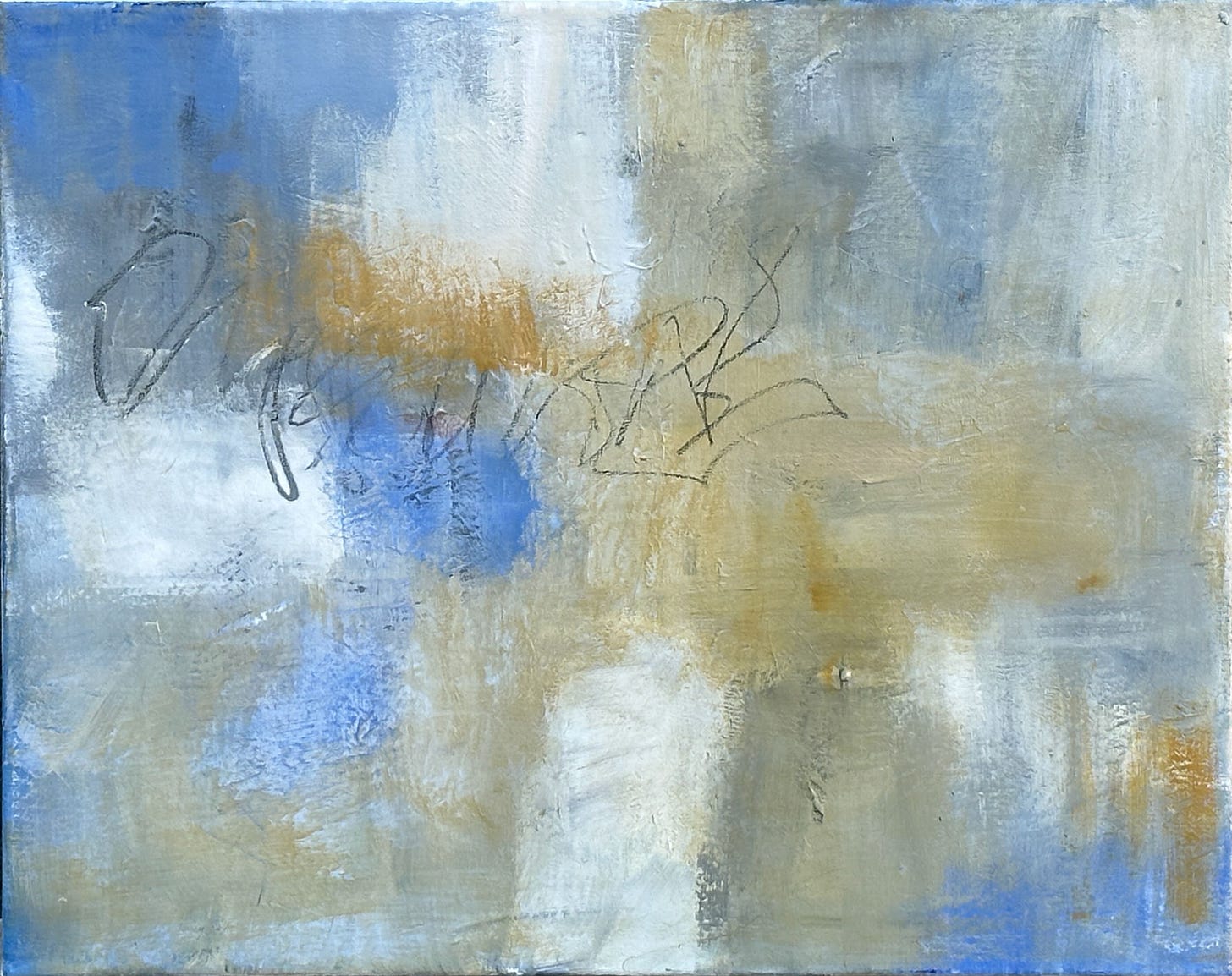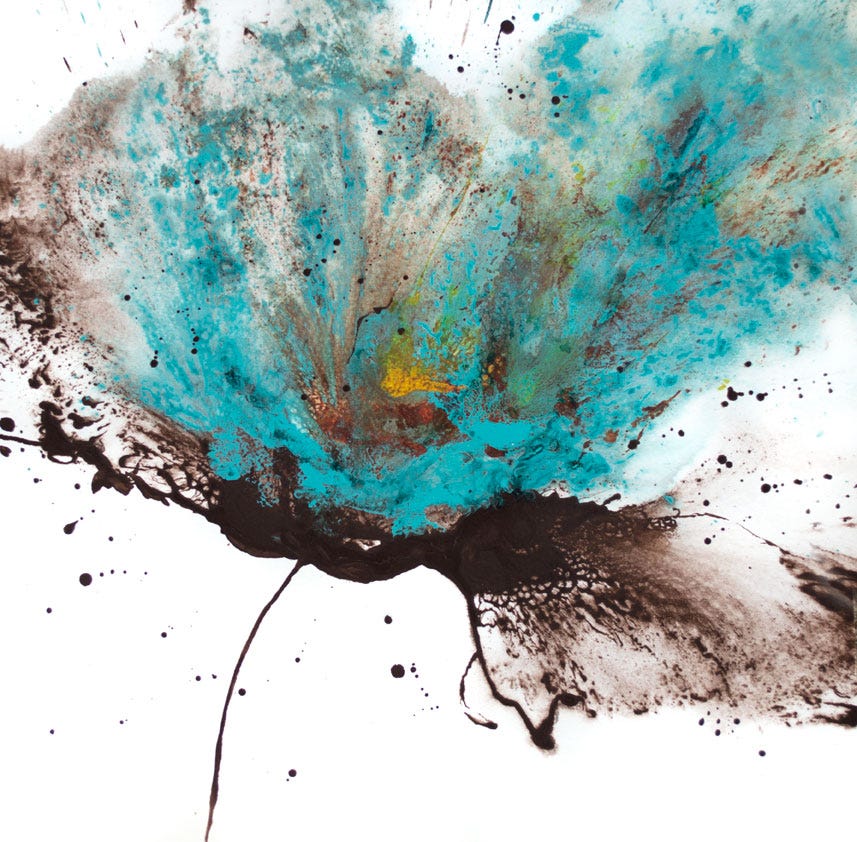quantity creativity & quasi-quitting
two reinvention practices that are better together

I love writing because it’s so quick to go from idea to a written version of that idea, a manifestation of that idea in the world. I did that with my LinkedIn article on quantity creativity. I kept coming across Cal Newport’s idea of slow productivity, as he promoted his new book. There are other productivity gurus and books promoting the same thing: ruthlessly prioritize, focus on one or a few things, do less not more. Essentialism by Greg McKeown has long been one of my favorite books, yet I never have succeeded in putting it into practice.
Minimalism doesn’t work for me, in my work life at least (whether that’s work for pay or creative work for joy).
I love painting because it mixes up the usual order of idea and manifestation of idea in the world. I usually don’t start with an idea, or at least not a very well formed one. I start with action. I start with a blank canvas and a few tubes and bottles of paint, a tub of water, and my favorite paintbrushes. I mix some colors. I cover the canvas with color, add some shapes and marks, draw into it with a china marker. I let it dry. I add some layers of glaze. I leave it alone for a while. Then somehow I become motivated to work on it again. I see where it’s going, and I encourage it in that direction. I take an analytical look at it. How is the contrast, the composition, the rhythm? Slowly, it turns into a painting I’m happy to put on my wall, put on my website. My favorite part is giving it a name. Many of my paintings have the numeral one at the end of their name. That’s because I expect to do more of them. More reminiscences of a quick trip to Pacifica. Another submersion into the joy and coolness of a pool.
Not always though. The painting I’ve shared above no longer exists. As I was trying to make it better, make it finished, I ruined it. I ended up painting over it entirely. I’m not even sure which of the many canvases in my studio have that painting underneath whatever’s there now. I love the color scheme though, and the scribbling china marker line. I may start with that idea again. It was an idea of spring when it started. I tried putting abstract flowers on it, that’s what ruined it. I’m going to go back and try that idea again.
Focusing on quality doesn’t work for me in painting. I’ve tried. I’ve tried buying a really nice canvas and planning out a painting carefully, even writing down colors and steps I’m going to take. That has never worked. I don’t know ahead of time which will be my favorite paintings, or anyone else’s. One of my friends likes all my boldly colored paintings but to me they look too saturated. Tastes differ.
What does work for me, in painting and writing and in life in general, is increasing the quantity of my output. I’m not the only one who has found that. I call this quantity creativity to set it up against Newport’s slow productivity.
with quantity creativity you need to know how to quit
You can’t just endlessly expand your output and activities in quantity and expect to find satisfaction and reinvention that way. It’s only one part of the problem. But standard quitting or quiet quitting doesn’t work either. How about quasi-quitting:
Quasi-quitting isn’t about slacking off and trying to slide by, hoping that no one in charge notices. It’s about doing more not less. Quasi-quitting is active, not passive. It’s powered by nimbleness and acumen, not apathy.
— Julia Keller, Quitting: A Life Strategy
Quasi-quitting and quiet quitting are not the same. I could never quiet quit. I am a loud quitter. Instead I quasi-quit my job so I could better practice quantity creativity.
Quasi-quitting is not extreme; it’s a course correction:
It doesn’t necessarily mean blowing up everything, clearing the deck, making a clean sweep. It can also mean a slight but crucial recalibration of strategies. Such a change can be just as solid and consequential as a dead stop. It’s a way of taking what you already know and using it as you move forward, instead of starting from absolute zero.
That is exactly what I’ve been doing with my current reinvention. I didn’t leave the company I was working at entirely; I switched from being a full-time employee with managerial responsibilities to working half-time in an advisory capacity only. This gives me time to spend on my passion projects: writing about AI in a way that cuts through the hype, painting abstract acrylics, and studying career reinvention while going through it myself.
Keller says of quasi-quitting: “it’s about doing more not less.” But that’s not entirely true. Quasi-quitting, the way I’m practicing it, can be about doing less, but in a very targeted way. Quasi-quitting is taking the best of an activity and only the best of an activity, and distilling your focus to that. This overlaps with quantity creativity an a synergistic way.
interlocking reinvention practices
Quantity creativity and quasi-quitting go together. With quantity creativity, you expand your options. You do more things without a lot of analysis and thinking about whether they will work or not. That can mean expanding categories of things you do (starting a newsletter when you’ve never written one before?) or doing more of what you’re already doing (publishing newsletter articles more frequently).
But then with quasi-quitting you regularly review how your activities are going. You take a more analytical and reflective approach. Which activities are satisfying, inspiring, and meaningful? Which ones drain you? It’s important to give things a chance and not give up too early. But even after a few weeks of a new activity you will have some idea of how well it’s working. With quasi-quitting you aren’t going to completely eliminate it, but you can change it up based on what you’ve learned.
Plus, quasi-quitting frees up time and mental space to expand possibilities again. Sometimes you need to quasi-quit first before you start some quantity creativity. Other times, fallow times, you may be ready to start by adding rather than subtracting.
Quasi-quitting practice
Ask yourself: Is there something in your life that’s not quite working? You don’t need to quit it entirely. Think of a few ways you could slightly change it up, make a little course correction, make it more fun and inspiring to you. If it’s taking too much time, can you work to reduce it somehow?
Quantity creativity practice
Ask yourself: What activity do you want to bring more of into your life? Could you explode your practice of it ten-fold, by an order of magnitude? Thinking about such an incredible increase will expand your thinking around what might be possible even if you decide not to take that particular explosion on.
My reinvention practices for next week
Quasi-quitting: I am going to change up my work on reinvention a bit, reducing the number of interviews I take on, and increasing writing from what I have learned already. Once I get my new reinvention website launched (this week, I hope) I will write more about this quasi-quit.
Quantity creativity: I am going to do a bunch of abstract floral paintings this week. This is something I’ve only done a little of and haven’t explored enough to get comfortable with it.
Here’s an abstract floral I really love:

What I love: the watercolor-like use of acrylic, the burnt umber lines with spatters, teal blue against the brown, and then the red and yellow in the center of the flower as an accent, plus some green where the blue and yellow mixed. The dark shape of the calyx draws the eye to the colorful center of the flower. Gorgeous!
More floral and flower paintings by Catherine Jeltes here.
Anne Zelenka is a painter, a mother, a writer, a researcher, and a serial career reinventor. She occasionally writes about AI. She lives in Highlands Ranch, Colorado with her 20-year-old daughter, 80-year-old mother, four cats, and a puppy.




